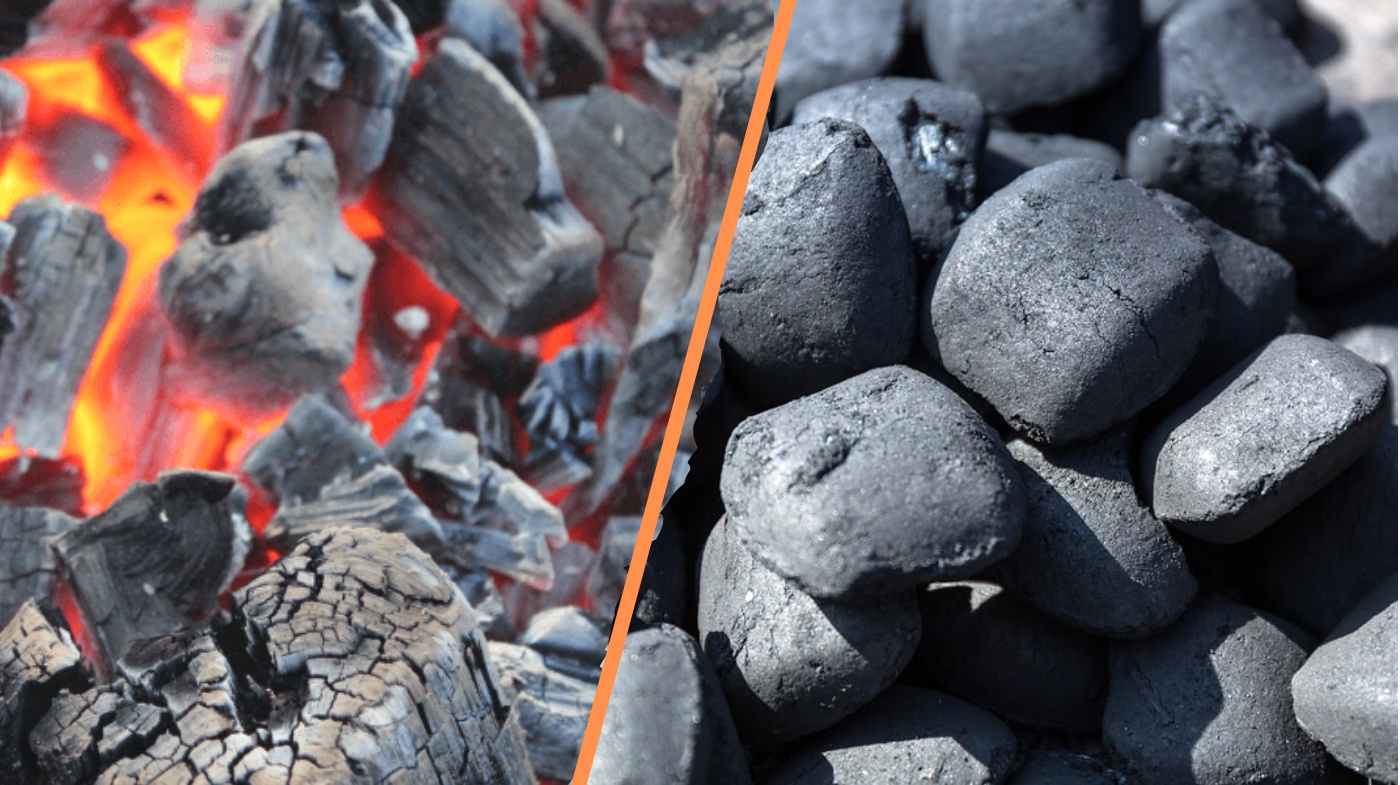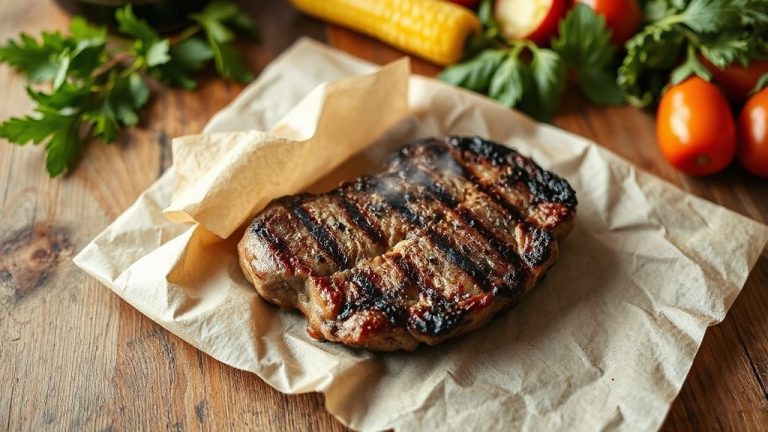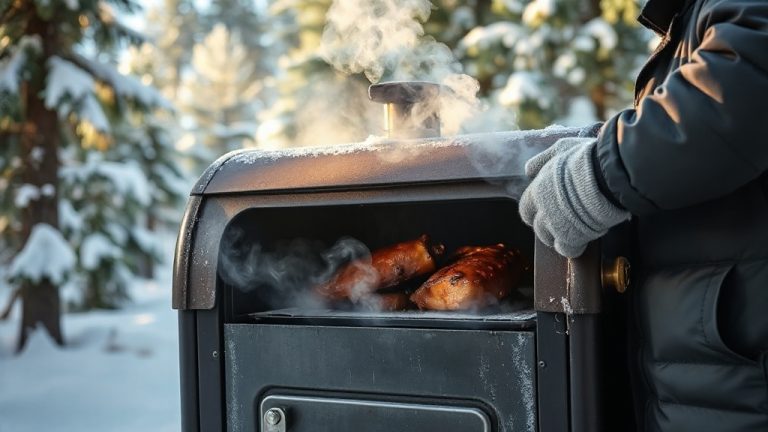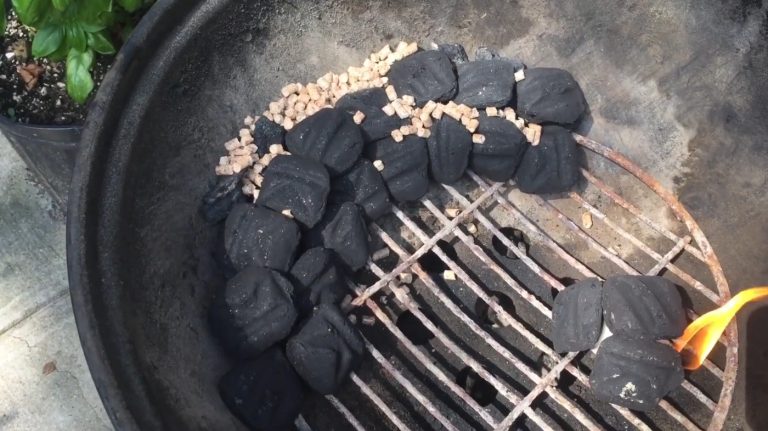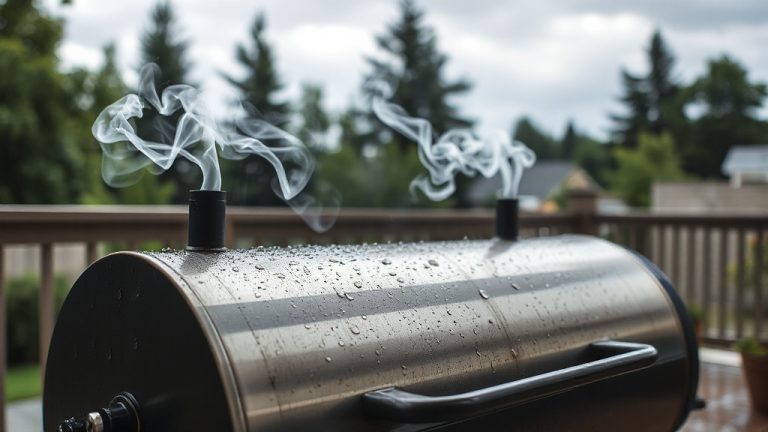Can You Mix Lump Charcoal with Briquettes? Things to Know
Yes, you can mix lump charcoal with briquettes to get the best of both worlds. Lump charcoal lights quickly and burns hotter, giving you a natural smoky flavor, while briquettes provide steady, longer-lasting heat that helps maintain consistent temperatures.
Combining them offers better heat control and efficient cooking. Just be mindful of storage and ventilation to keep your charcoal dry and safe. To get the most from your grill, it helps to understand how each type affects flavor, burn time, and cleanup.
Key Takeaways
- Yes, mixing lump charcoal and briquettes combines quick, hot burns with steady, longer-lasting heat for better temperature control during cooking.
- Lump charcoal adds natural wood flavor and less ash, while briquettes provide consistent heat and cost-effectiveness when used together.
- Mixing may cause uneven burn times and temperature fluctuations, requiring careful airflow and monitoring for optimal results.
- Store mixed charcoal in airtight, dry containers away from moisture and heat to maintain fuel quality and performance.
- Use sustainably sourced lump and additive-free briquettes when possible to reduce environmental impact and ensure safer cooking.
Benefits of Combining Lump Charcoal and Briquettes
While lump charcoal burns hotter and faster, briquettes provide a steadier, longer-lasting heat, making their combination ideal for managing cooking temperatures effectively.
Lump charcoal ignites quickly and hot, while briquettes offer steady, enduring heat for perfect temperature control.
You get a quick heat boost from lump charcoal for searing, while briquettes maintain consistent warmth for slower cooking like smoking. This mix also balances flavors—lump charcoal adds a natural wood-fired taste, and briquettes offer a neutral background, enhancing overall flavor complexity.
Using both types can be more cost-effective too, since briquettes are cheaper and burn longer. You can adjust heat easily by varying the amounts of each charcoal type, reducing temperature swings during cooking.
Many experienced cooks find that mixing helps control ash production and temperature stability, improving the overall cooking process. Whether you’re grilling or smoking, combining lump charcoal and briquettes gives you flexibility, better heat control, and improved flavor in one practical setup.
Key Differences Between Lump Charcoal and Briquettes
You’ll notice some key differences between lump charcoal and briquettes, such as:
Composition and Ingredients
Because lump charcoal is made from pure wood carbonized without chemicals, it offers a natural and lighter fuel option that burns cleaner with less ash. Its pieces vary in shape and size, reflecting the natural wood source, and contain no additives.
On the other hand, briquettes are manufactured from a mix of materials like sawdust, coal dust, and chemicals, compressed into uniform shapes. This dense packing makes briquettes heavier and more consistent in size but can produce more smoke and odor due to their additives.
Additionally, briquettes generally cost less per pound and provide more burn for the cost thanks to their uniform shape and size.
When mixing the two, understanding these composition differences helps you balance natural burning qualities with longer-lasting, steady heat from briquettes, optimizing your grilling experience without compromising on fuel quality or cooking performance.
Burn Time and Heat
How long your fuel burns and how much heat it produces can make a big difference in your grilling or smoking results. Lump charcoal burns hotter initially, reaching peak heat quickly but only sustaining high temperatures for about 15 minutes before dropping to medium-high.
It generally burns for 2-3 hours but requires careful airflow control to maintain temperature. Tests have shown that burn times vary significantly among different lump charcoal types, with denser charcoals like Cowboy lump offering longer burn durations.
Briquettes, on the other hand, provide a steadier, medium-high heat for around 45 minutes or longer, ideal for longer cooking sessions. They burn more consistently and respond less dramatically to airflow changes.
Mixing the two can cause uneven burn times and temperature fluctuations, making it tough to control your grill. If you want predictable heat, it’s best to choose one type based on whether you need quick, intense heat or prolonged, steady warmth.
Flavor and Ash Output
Although both lump charcoal and briquettes serve the same purpose, they differ markedly in flavor and ash output. Lump charcoal offers a natural, woodier smoke flavor with minimal ash, enhancing your grilling experience.
Briquettes burn longer with a consistent heat but produce more ash and a milder flavor due to fillers and additives. One important consideration is that briquettes often contain chemical additives, such as borax and limestone, which can affect both flavor and safety. Here’s a quick comparison:
| Feature | Lump Charcoal | Briquettes |
|---|---|---|
| Flavor | Strong, natural wood smoke | Milder, sometimes neutral |
| Ash Output | Low, easy cleanup | High, more residue |
| Additives | None or minimal | Fillers and chemicals |
| Burn Consistency | Variable | Uniform |
| Impact on Flavor | Enhances smokiness | Less smoky |
Choose based on whether you prioritize flavor or consistent heat with easier management.
Effective Techniques for Mixing Charcoal Types
When you mix lump charcoal with briquettes, you gain better control over flavor and temperature during your cook. To use this combination effectively, consider layering lump charcoal beneath briquettes to balance a hotter burn with longer-lasting heat.
Because lump charcoal comes in irregular shapes and sizes, arranging it properly is crucial to avoid gaps that can cause inconsistent heating and burn rates irregular shapes.
The T-plate method lets you create thirds of lump, briquettes, and mixed charcoal for gradual temperature shifts. You can also adapt the Minion Method by placing lit briquettes on unlit lump for consistent ignition.
Try the T-plate for steady heat or the Minion Method to light briquettes on unlit lump charcoal consistently.
Adjust your mixing ratio based on how much smoky flavor or steady heat you want.
- Layer lump charcoal under briquettes for balanced burn
- Use T-plate method to separate charcoal types evenly
- Adapt Minion Method for mixed charcoal ignition
- Vary ratios to customize flavor and burn time
Managing Temperature and Ventilation When Mixing
Mixing lump charcoal with briquettes gives you more control over your cooking, but managing temperature and ventilation plays a big role in getting the best results. Lump charcoal burns hotter and faster, while briquettes provide steady, longer-lasting heat.
To balance this, adjust your grill’s vents: open them to boost oxygen flow and raise temperatures, or close them to lower heat and slow the burn.
For low and slow cooking, partially closing vents helps maintain stable temperatures. Many users layer briquettes over lump charcoal to maintain consistent heat and extend cooking duration.
Lighting lump charcoal in a chimney starter promotes even ignition without lighter fluid, improving airflow control.
Keep a close eye on your thermometer and tweak vent openings as needed to manage the faster burn rate of lump charcoal and the steady heat from briquettes, ensuring consistent cooking performance.
Storage Tips for Mixed Charcoal
You’ll want to store mixed charcoal in a cool, dry place away from direct sunlight and moisture to preserve its quality. Use airtight metal or plastic containers to keep the charcoal safe and prevent dampness.
Always guarantee proper ventilation and safety by keeping storage areas secure and free from potential fire hazards. Charcoal stored properly can last indefinitely if kept in a cool, dry environment.
Ideal Storage Conditions
Although storing mixed charcoal might seem straightforward, maintaining ideal conditions is essential to preserve its quality and effectiveness.
You’ll want to control temperature, humidity, and light exposure to avoid moisture buildup and degradation. Proper storage in a dry, airtight container can significantly extend the shelf life of charcoal.
Proper ventilation prevents gas accumulation, while keeping charcoal away from ignition sources ensures safety. A clean, dry, and well-ventilated area will help maintain your charcoal’s performance over time.
Keep these key points in mind:
- Store charcoal in a cool, dry place between 15°C and 25°C with low humidity.
- Protect it from direct sunlight and UV rays to maintain quality.
- Ensure good airflow to prevent odors and gas buildup.
- Keep charcoal away from flames, sparks, and heat sources for safety.
Container Recommendations
When storing mixed charcoal, choosing the right container is essential to keep it dry, fresh, and ready for use. Look for weatherproof, sealed containers made from durable plastics like polypropylene or polyethylene.
Brands like Kingsford, Master Forge, and Traeger offer options with heavy-duty handles for easy transport and capacities ranging from small units to large 55-pound containers.
Using a container with separate compartments helps you keep lump charcoal and briquettes organized. One popular choice is the Traeger Plastic Storage Bin, which holds up to 22 pounds and comes with a secure lid to protect your charcoal from moisture.
Always make certain the container is completely dry before adding charcoal to prevent moisture buildup. Label your containers clearly, and store them in a dry, protected area.
Safety and Ventilation
How can you guarantee your mixed charcoal stays safe and ready to use? Proper storage and ventilation are key. Keep your lump and briquettes in a dry, airtight container to avoid moisture, and store them off the ground to prevent dampness.
Confirm the storage area is well-ventilated and away from direct sunlight or flammable materials to reduce fire risk and maintain quality. Regularly check for any signs of moisture or damage to keep your charcoal effective. Proper storage prevents moisture absorption, preserving quality.
- Store mixed charcoal in a cool, dry place with proper airflow
- Keep containers labeled and separate different charcoal types
- Maintain distance from flammable items and direct sunlight
- Use gloves and tools when handling charcoal to stay safe
Environmental Considerations and Sustainability
Because charcoal production impacts both forests and air quality, you need to contemplate the environmental footprint when mixing lump charcoal with briquettes.
Lump charcoal, if not sustainably sourced, contributes to deforestation and carbon emissions. Briquettes often use waste wood but contain additives that harm air quality.
Mixing them doesn’t reduce pollution but can slightly improve sustainability if you choose responsibly sourced options. Both release pollutants like VOCs and carbon monoxide, affecting health and the environment.
It is important to note that charcoal’s lifecycle includes raw material extraction, production, use, and disposal, all contributing to its overall environmental impact.
To lessen your grilling impact, avoid lighter fluids and self-lighting briquettes, and consider sustainable charcoal or alternatives like propane.
Frequently Asked Questions
Does Mixing Charcoal Types Affect Grill Cleaning Frequency?
Yes, mixing charcoal types can affect how often you clean your grill. Briquettes produce more ash than lump charcoal, so when you combine them, expect increased ash buildup.
This means you’ll need to empty the ash catcher more frequently to maintain proper airflow and grill performance. Regular cleaning prevents ash overflow and keeps your grill working efficiently.
Can Mixed Charcoal Be Used in All Grill Types?
Think of mixed charcoal like a well-rehearsed orchestra: each type plays its part to create balanced heat. You can use mixed charcoal in most charcoal grills without issue, but avoid pure gas grills—they’re not designed for solid fuels.
Hybrid grills handle mixed charcoal if airflow and compartments fit both types properly. Just balance lump’s quick heat with briquettes’ steady burn, and monitor temps to get the most from your grill.
How Does Mixing Charcoal Impact Fuel Ignition Time?
Mixing lump charcoal with briquettes speeds up your fuel ignition time because lump charcoal lights quickly due to its porous nature and lack of additives.
Once lit, the slower-burning briquettes maintain steady heat, so you won’t have to wait long for the fire to get going, and it’ll last longer. Just remember to manage airflow carefully since the combination changes how your fire behaves during startup and cooking.
Are There Any Health Risks From Burning Mixed Charcoal?
Yes, burning mixed charcoal can pose health risks. You’ll inhale particulate matter and pollutants that may cause respiratory issues and even cardiovascular problems. Briquettes often contain additives, which release harmful chemicals when burned, increasing exposure risks.
To protect yourself, always use proper ventilation and avoid enclosed spaces. Managing ash and fire safely also helps reduce harmful exposure.
Can Mixed Charcoal Affect the Appearance of Grilled Food?
Yes, mixing lump charcoal and briquettes can affect your grilled food’s appearance. Briquettes produce more white ash, which might settle on your food, leaving a powdery look.
Lump charcoal burns hotter and cleaner, creating less ash and a cleaner surface. When mixed, you may see uneven charring, variable ash fallout, or duller colors due to additive residues in briquettes. Managing airflow and charcoal placement helps maintain a better appearance.
Experience the Ultimate Grilling Power with the Perfect Mix
Mixing lump charcoal with briquettes can supercharge your grilling experience like a flavor explosion in every bite. By combining their unique benefits, you get longer burn times and better heat control.
Just manage your temperature and ventilation carefully, and store your mix properly to keep it fresh. Remember, a well-mixed charcoal blend not only boosts your cooking but also helps you grill smarter and more sustainably. Get ready to impress every time.
